The Intel SSD 540s (480GB) Review
by Billy Tallis on June 23, 2016 9:00 AM ESTMixed Random Read/Write Performance
The mixed random I/O benchmark starts with a pure read test and gradually increases the proportion of writes, finishing with pure writes. The queue depth is 3 for the entire test and each subtest lasts for 3 minutes, for a total test duration of 18 minutes. As with the pure random write test, this test is restricted to a 16GB span of the drive, which is empty save for the 16GB test file.
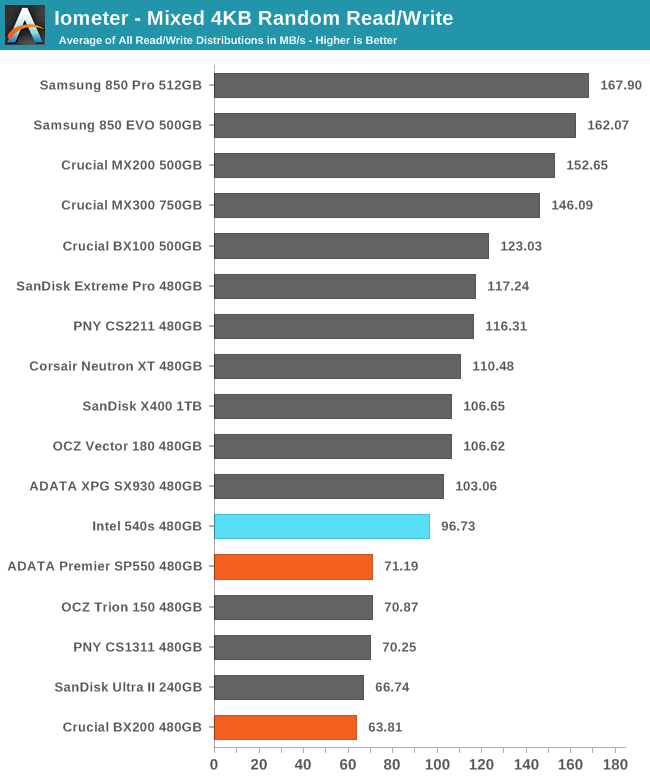
On the mixed random I/O test the Intel 540s has a stark advantage over almost all other planar TLC drives, and is close to the low-end MLC drives and SanDisk X400.
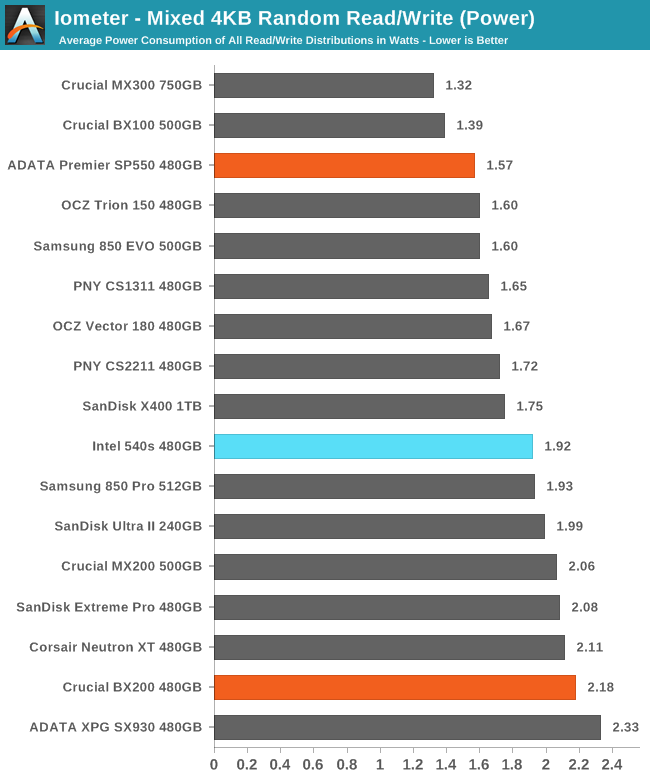
Power consumption is middle of the road, so the Intel 540s comes out at ahead of most of the TLC drives in terms of efficiency, though the SP550 is not far behind.
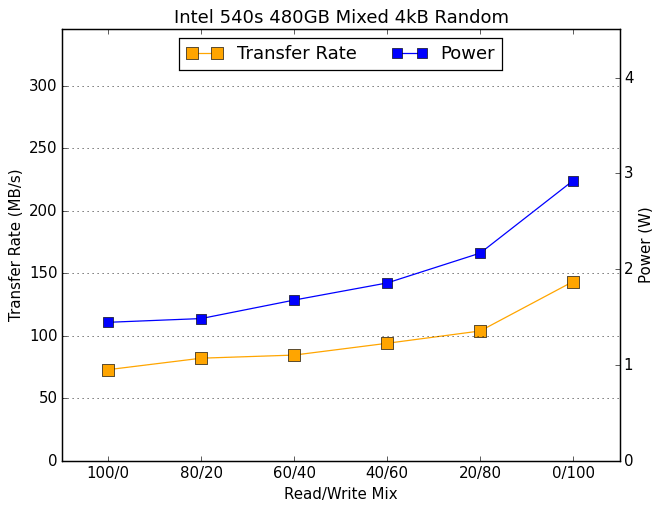 |
|||||||||
The performance of the Intel 540s never dropped as the proportion of writes in the workload increased, but it also didn't show the common big jump in performance during the final pure-write phase of the test.
Mixed Sequential Read/Write Performance
The mixed sequential access test covers the entire span of the drive and uses a queue depth of one. It starts with a pure read test and gradually increases the proportion of writes, finishing with pure writes. Each subtest lasts for 3 minutes, for a total test duration of 18 minutes. The drive is filled before the test starts.
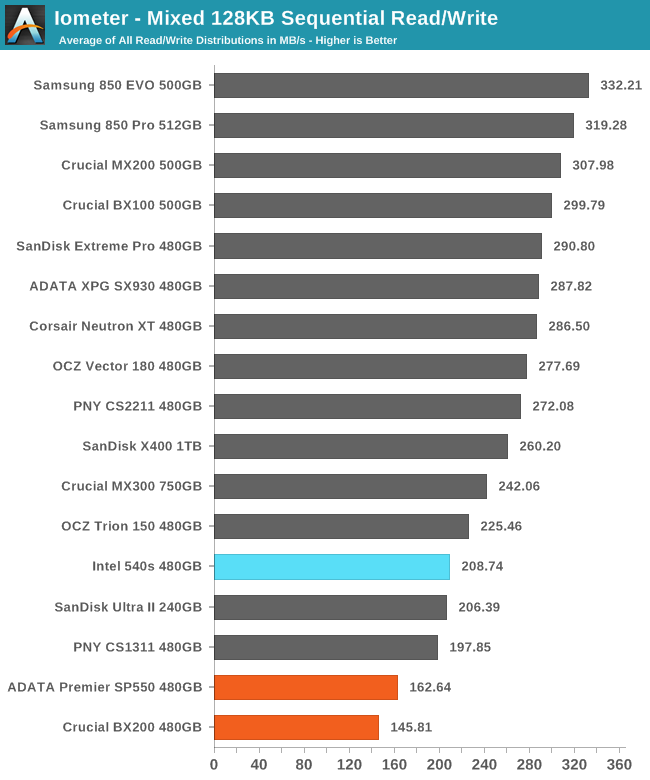
The mixed sequential I/O performance of the Intel 540s is significantly improved over the SM2256 drives, but that still only brings it up to par for planar TLC.
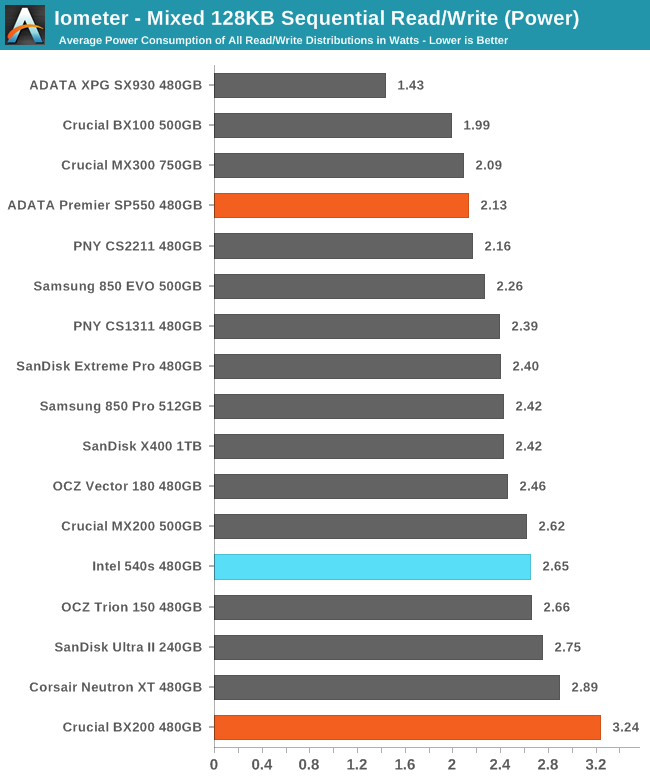
The power usage of the Intel 540s is relatively high, so it doesn't have great efficiency even by TLC standards.
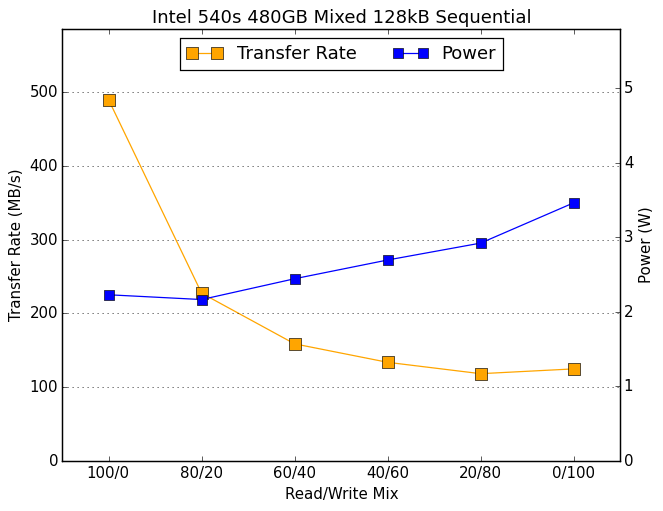 |
|||||||||
The Intel 540s is both faster and more power hungry than the SP550 at every point during this test. Performance still doesn't bounce back appreciably with the pure writes phase of the test, which keeps the average down despite the good read performance at the beginning.










77 Comments
View All Comments
cbjwthwm - Tuesday, June 28, 2016 - link
I'll pay a premium vs a generic like the SP550 because:1. Intel will undoubtedly manufacture the drive to reliable standards
2. it will be supported by a decent toolbox utility (eg: ADATA's is buggy junk)
3. Intel will rake SMI's controller firmware over the coals, like it did with Sandforce--an update has already been released since this review
4. its firmware update process will be simple & reliable
I picked up an SP550 for eval which eventually needed a firmware update. After experiencing the SP550's nasty firmware update process (a disorganized DIY mess), I now use BX200's as the cheapest drive choice simply because firmware updates are competently packaged. I've also had scenarios where fully updated OCZ Trions had terrible stuttering, and imaging to a BX200 solved the issue as well.
I see Intel's 540s as the combination of what the SMI-based TLC products like the SP550 and BX200 should be, if you combine their positive attributes (beyond price)--and for light load applications those benefits could sway me away from equivalently priced MLC-based drives with similar support issues and potential reliability compromises.
Samsung also has crappy firmware support (eg: the repeated 840 EVO performance fixes, and the 850 series update bricking issues which were pulled) so I rarely ever use them. Samsung may have an engineering lead, but they have a well established history as a consistently reckless company when it comes to support.
vladx - Tuesday, June 28, 2016 - link
Another idiot spreading FUD about Samsung. 840 EVO works great and as new after applying the fix. Stuff like the trash you posted starts stupid myths that average joes keep repeating.cbjwthwm - Wednesday, June 29, 2016 - link
Myths? There is an established track record with them, widely reported and easy to find.1. Multiple rounds of 840 EVO firmware: http://www.anandtech.com/show/9196/samsung-release...
2. 850 firmware pulled, and the ISOs were never re-released: http://www.guru3d.com/news-story/after-samsung-840...
fanofanand - Thursday, June 30, 2016 - link
The evo issue was legitimate. That said, it isn't like Intel hasn't released a few turds in their day as well. Between broken AVX and numerous other problems, Intel is not the holy grail of perfection and quality control. Samsung has at least as strong a track record for reliability with their drives as Intel, so it makes no sense to purchase this over the comparatively priced Samsung drive. You reference "premium vs generic" but line this up in the premium vs premium space and you will find this drive underperforms and is overpriced. You are either an Intel shareholder, employee, or don't use critical thinking when it comes to your beloved brand.vladx - Thursday, June 30, 2016 - link
There were issues which they fixed. I call that great support from Samsung. It's FUD to say Samsung has a bad history based on fixed issues.Prof-Q - Tuesday, August 16, 2016 - link
If Intel 540 and Adata SP550 used the same NAND, then why Intel's performance is so much better in UsersBenchmark?I was about to buy Intel but this article made me reconsider the options
SeanJ76 - Tuesday, October 4, 2016 - link
Intel will still be the king of SSD's, their top tier is no 1 in speed and reliability(Pci-e) version, their mid tier is holding their own as well, and their entry level tier, 540 series, is so damn affordable for the reliability who wouldn't buy them? I own 4 Intel 520/535 series currently, 2 of them are over 5 yrs old and they are still at 100% life span according to Intel's Toolbox. The main difference in brands is reliability, now that they're all pretty much on par with speed, you should go with the reliability winner which is none other than INTEL!